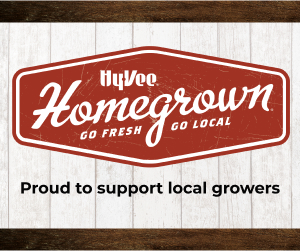Mainframe studio #455, where Alex Brown used to paint, now offers international artists a space to think and work. Photo: Duane Tinkey
Writer: Brianne Sanchez
Like a big blank canvas, Mainframe Studio #455 invites artists to imagine what could be. The 1,400-square-foot space features white walls, concrete floors and high ceilings.
Nearly empty, the corner studio could be a gallery between shows. But this is no museum. The light-filled room was one of the first artist-occupied workspaces in what is now the largest nonprofit studio building in the nation. Surrounded by creative energy, studio #455 serves to inspire guest artists from around the world.
The artists are part of the Alex Brown Foundation and Residency program, which was established to honor the life and legacy of its namesake, a Des Moines-based painter who died five years ago at 52. The residency program offers “emerging and established artists of exceptional merit” full access to the studio, nearby accommodations, transportation and a stipend so they can focus on their creative work for two or three months at a time.
It’s an attractive opportunity for artists like Arel Lisette and Alina Perez, who used their 2022 residency to shape a two-person show for a prominent gallery in New York. Lisette said she was inspired by the Des Moines Art Center’s collection and the time she spent with her collaborator. As she put it, “Sharing a studio with another artist is an incredibly unique and intimate experience. Working alongside Alina in Des Moines allowed us to have deeply personal and formative conversations about our work.”
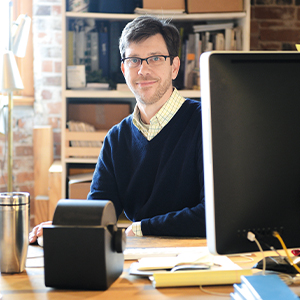
Trading a scene for a community
Alex Brown was an accomplished painter who grew up on Des Moines’ west side. He was part of the early punk scene and made ’zines and music both here and in New York. He earned an art degree from Parsons School of Design and played guitar in a hardcore group called Gorilla Biscuits.
A New York Times art critic once praised Brown’s paintings for their tension between abstraction and illusion. “Looking at one of his optically mesmerizing, subtly hued canvases is something like looking at a photograph through a patterned shower curtain,” critic Ken Johnson wrote. “The image is atomized almost beyond recognition into a multilayered, intricately gridded field of spots, triangles, ovals, cubes or blossom shapes.”
The artist’s older brother, Christopher Brown, said that in some of his paintings, “you could recognize what you were looking at, but he was dialing up the enigma. It was sort of charismatic and close and emotionally remote at the same time — all qualities that were also true of the artist.” Many of Alex’s paintings ended up in private and museum collections across the country.
“Alex was represented by this hot gallery in Chelsea and had a bunch of solo shows and a great trajectory, but then in the mid-’90s, he decided to move back [to Des Moines],” Christopher said during a call from his home in Austin, Texas. “As your typical Des Moines expat, I was always like, ‘Why aren’t you back in New York?’ It was only when the tragedy of his death happened that I really understood that Des Moines was integral to his process as an artist.”
Alex hadn’t planned to stay in Des Moines for long. But 20 years and multiple studios later, it was clear that his hometown was more than an affordable home base for an international career. Christopher said that reading through some of his brother’s fellowship applications helped him understand why he stayed.
“It was only when he got to Des Moines that his work could really take the shape that he wanted it to,” Christopher said. “When he escaped from the metropolitan ‘anxiety of influence’ and the gaze of others, he could paint what he wanted to see.”
With money from Alex’s savings and donations from friends and family, Christopher and the brothers’ parents, William and Sibylla Brown, set up the memorial foundation and residency. It lets other artists experience a bit of the support and infrastructure that Alex enjoyed in Des Moines, along with the physical and mental space that can help artists make meaningful work.
Alex himself was an anchor tenant at Mainframe and worked in studio #455 up until his death. His desk and stool sit next to a bay of tall windows overlooking Keosauqua Way, where it intersects the interstate. A few other tables, supply shelves, ladders and chairs occupy the far wall. The space offers visiting artists a sense of hospitality and creative breathing room.
“I was immediately struck by how welcoming everyone in Des Moines was,” said Lisette, one of the 2022 residents, who grew up on the West Coast and lives on the East Coast. “Coming to Des Moines, with its shorter buildings, more open skies and kind people, felt like returning to someplace familiar.”

The New York artist Ben Duvall’s 2023 installation at Mainframe Studios drew from historical research, artifacts and ephemera, including this cart and reproduced news article. Photo: Nicole Trower
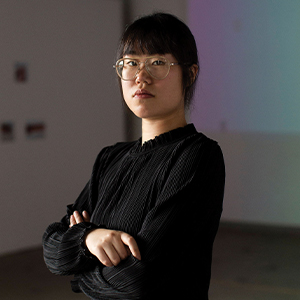
Resident artist Fanxi Sun from China used the residency to start a project that explored the function and symbolism of mirrors, and the relationship between segments and a whole. Photo: Nicole Trower
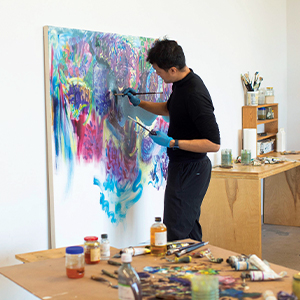
Leonard Yang’s childhood in Singapore and experiences as an immigrant influenced the colorful paintings he created here in Des Moines. Photo: Nicole Trower
Local and global connections
When the Alex Brown Foundation launched its residency program in 2021, its founders recruited its first participants from their personal networks. The New York-based artist Douglas Ross, one of Brown’s friends and former studiomates, guides the annual selection process. This year, the jury chose five applicants from a pool of 530.
The jury favors artists whose work “contributes to contemporary conversations about where art is, where it’s going, what artists care about and what’s going on in the universe,” Ross said.
This year’s four residents join the list of 15 artists who’ve come since the program started:
Fatma Belkıs of İstanbul, Türkiye, works with text, video and printed materials. She applied for the residency to enable work on “a docu-fiction project” about fear and rage.
Woohee Cho, is a visual artist based in Los Angeles and Seoul who creates installations, videos and performances around queer themes.
Mark Joshua Epstein from Ann Arbor, Michigan, is exploring the history of Jewish immigration to Iowa dating back to the mid-19th century. He proposed photographing architectural motifs.
Anjan Modak, who lives and works in Kolkata, India, creates images of the lives of urban manual laborers, such as migrant construction workers. His large drawings on paper often portray the workers’ lives in metaphorical ways.
The residents aren’t required to participate in Mainframe Studios’ First Friday open houses, but many take advantage of the environment to showcase their work and tap into other local artistic resources during their months in Des Moines.
“It’s important for any artist to have time and space to make and fail, and that’s what this residency affords,” said Julia Franklin, Mainframe’s executive director. “Artists need funding and studio space for great ideas to happen.”
Franklin used to be a Mainframe tenant and rented studio #456, right across the hall from Alex Brown. She remembers tossing cardboard in the wrong receptacle when she was still new. “Alex walked me down to the dumpster, made me get in and pull them all out and put them in the right one,” she recalled. “I learned how to treat the building and respect the space.”
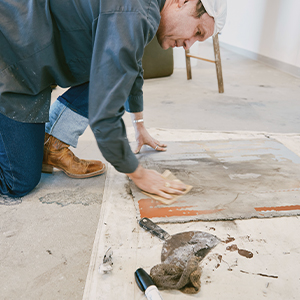
The New York artist David Dixon knew Alex Brown from his stint out East. During Dixon’s 2023 residency in Des Moines, he worked on a series of silk-screened plaster paintings while one of Brown’s paintings hung in Dixon’s gallery in Brooklyn. Photo: Joe Crimmings
Read more about Alex Brown and his artwork in a 2013 profile headlined “Hidden Treasure.”







